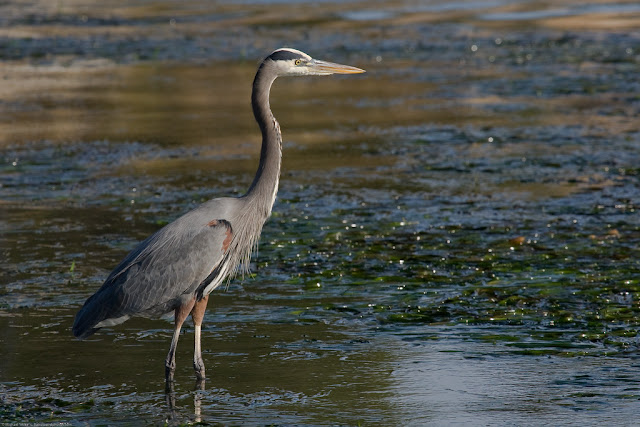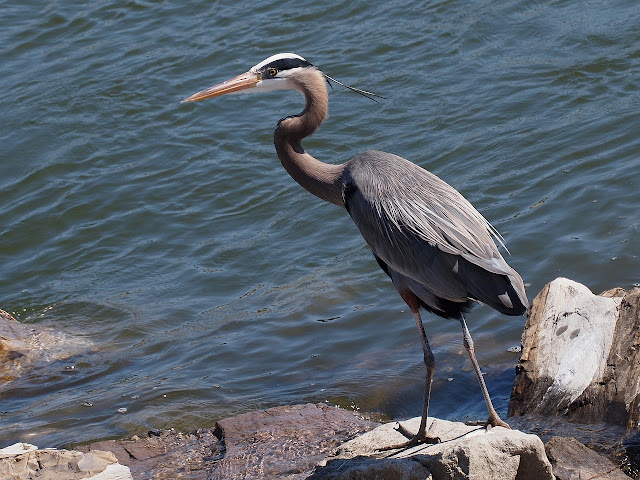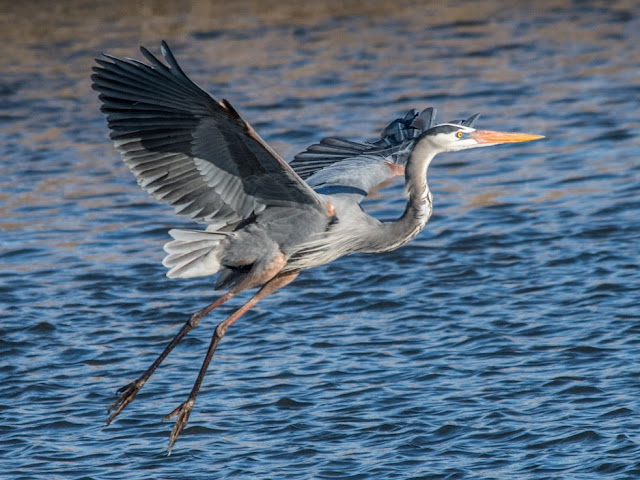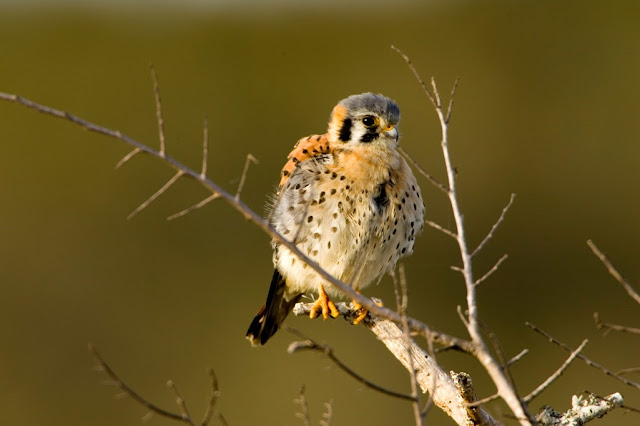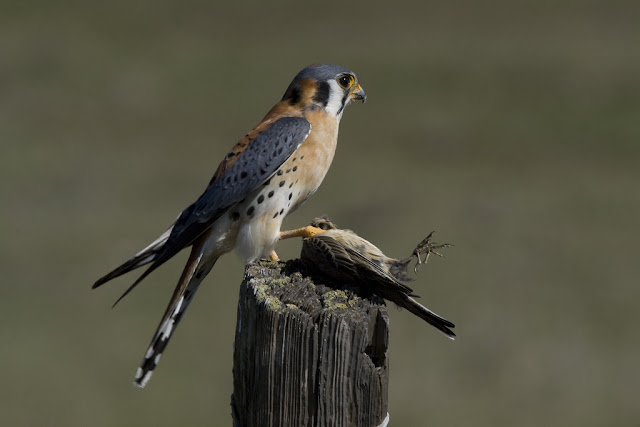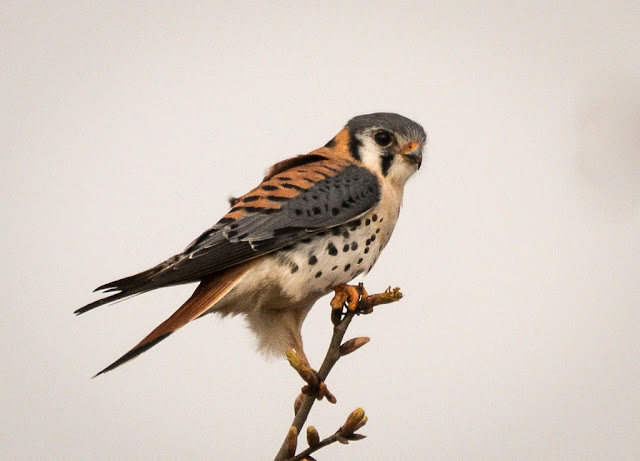Herons, egrets, and
bitterns are medium to large wading birds with long necks and spear-like bills.
Nearly all species feed primarily on aquatic animal life e.g., fish, frogs,
crayfish, insects. The common along the margins of most freshwater and saltwater
bodies and wetlands. Their long legs, necks, and bills are adapted for wading
in shallow water and stabbing prey.
Most species build
their nests in trees near their foraging habitat, and many nests colonially.
Members of this group range in size from the least bittern 28-36 cm bill tip to
tail tip to the great blue heron 106-132 cm tall. The sexes are similar in size
and appearance.
The great blue heron
(Ardeaherodias) is the largest member of the group in North America and feeds
primarily on aquatic animals. It is widely distributed in both saltwater and
freshwater environments. There are following subspecies in the United States
and Canada:
- h.
wardi (Kansas and Oklahoma across the Mississippi River to Florida).
- h.
herodias (remainder of the North and Central American range).
- h.
fannini (Pacific coast of North America from Alaska to Washington).
- h.
occidentalis (extreme south of Florida)
- h.
occidentalis (the great white heron) is an all-white color morph that was
formerly considered a separate species.
Body Size
Males average
slightly heavier in weight than females. Northern continental herons are
somewhat smaller than those found in the south determined a relationship
between age and body weight for nestling great blue herons where BW equals body
weight in grams and A equals age in days.
Great Blue Heron
Habitat
Great blue herons
inhabit a variety of freshwater and marine areas, including freshwater lakes
and rivers, brackish marshes, lagoons, mangroves, and coastal wetlands,
particularly where small fish are plentiful in shallow areas. They are often
seen on tidal flats and sandbars and occasionally forage in wet meadows,
pastures, and other terrestrial habitats.
Great Blue Heron Nest
Great blue herons
tend to nest in dense colonies or heronries. The location of the heronry is
generally close to foraging grounds, and tall trees are preferred over shorter
trees or bushes for nest sites. They also may nest on the ground, on rock
ledges, or on sea cliffs.
Great Blue Heron Food
Habits
Fish are the
preferred prey, but great blues also eat amphibians, reptiles, crustaceans,
insects, birds, and mammals. When fishing, they mainly use two foraging
techniques: standing still and waiting for fish to swim within striking
distance of 2-3 Great Blue Heron slow wading to catch more sedentary prey (such
as flounder and sculpin). To fish, they require shallow waters (up to 0.5 m)
with a firm substrate.
Fish up to about 20
cm in length were dominant in the diet of herons foraging in southwestern Lake
Erie, and 95 percent of fish consumed by great blues in a Wisconsin population
was less than 25 cm in length. Great blues sometimes forage in wet meadows and
pastures in pursuit of lizards, small mammals, and large insects.
In northern areas,
small mammals such as meadow voles may be an important part of the diet early
in the breeding season, possibly because some aquatic foraging areas may still
be partially frozen when the herons arrive. Consumption of larger prey (fish,
frogs, rodents) is often followed by drinks of water; terrestrial prey such as
voles are usually dunked in water before they are swallowed.
Adult herons tend to
deliver the same type and size of food to their nestlings that they consume
themselves, but they deliver it well digested for young nestlings and less well
digested as the nestlings grow. Adults tend to feed solitary, although they
may feed in single or mixed species flocks where there are large concentrations
of prey, fledglings are frequently seen foraging together.
Molt.
Adults undergo a
complete molt in the late summer and fall and a partial molt of the contour
feathers in the late winter and early spring. Young herons attain full adult
plumage in the summer/fall molt at the end of their second year.
Great Blue Heron Migration
In the northern part
of its range, most great blues are migratory, some moving to the southern
Atlantic and the Gulf States to overwintering with the resident populations of
herons, others continuing to Cuba and Central and South America. Most migrating
herons leave their breeding grounds by October or November and return between
February and April.
Breeding Activities
and Social Organization
The male great blue
heron selects the site for the breeding territory, and nests generally consist
of a stick platform over 1 m in diameter. Great blues often use a nest for more
than 1 year, expanding it with each use. Mean clutch sizes range from three to
five in general, clutch size tends to increase with latitude.
Only one brood is
raised per year; however, if a clutch is destroyed, great blues may lay a
replacement clutch, usually with fewer eggs than the initial clutch. Both
parents incubate and feed the young. During the breeding season, great blues
are monogamous and colonial, with from a few to hundreds of pairs nesting in
the same area or heronry. Colonies may be 2-4 Great Blue Heron &
include other species, such as great egrets or double-crested cormorants.
Great Blue Heron
Range
Breeding colonies are
generally close to foraging grounds the distance between heronries and possible
feeding areas in Minnesota lakes to range from 0 to 4.2 km, averaging 1.8 km.
Another study found that most heroines along the North Carolina coast were located
near inlets with large concentrations of fish, an average of 7 to 8 km away.
Fifteen to 20 km is
the farthest great blue herons regularly travel between foraging areas and
colonies. In the northern portion of their range, great blue herons often build
nests in tall trees over dry land, whereas in the southern part of their range,
they usually nest in swamp trees, including mangroves.
Each breeding pair
defends a small territory around the nest, the size of which depends on local
habitat and the birds' stage of reproduction. Herons in some areas also defend
feeding territories. In other areas, great blues appear to be opportunistic
foragers, lacking strict fidelity to feeding sites. A study shows that herons
often returned to the same general areas, but different individuals often used
the same areas at different times.
Population density.
Because great blues nest colonially, local population density (i.e., colony
density, colony size, and the number of colonies) varies with the availability
of suitable nesting habitat as well as foraging habitat. On islands in coastal
Maine, Gibbs and others found a significant correlation between colony size and
the area of tidal and intertidal wetlands within 20 km of the colonies, which
was the longest distance herons in the study colonies traveled on foraging
trips.
In western Oregon,
the size of heronries was found to range from 32 to 161 active nests; the area
enclosed by peripheral nest trees within the colonies ranged from 0.08 to 1.21
ha. Population dynamics. Most nestling loss is a result of starvation, although
some losses to predation do occur. In a study of 243 nests in a coastal
California colony, 65 percent of the chicks fledged, 20 percent starved, 7
percent were taken by predators, and 7 percent were lost to other causes.
Estimates of the number of young fledged each year by breeding pairs range from
0.85 to 3.1.
Based on banding
studies, about two-thirds of the fledglings do not survive more than 1 year,
although they may survive better in protected wildlife refuges. Values for
later years indicate that about one-third to one-fifth of the 2-year-old and
older birds are lost each year.
Similar Species
The great egret
(Casmerodiusalbus) is almost the same size (96 cm length) as the great blue
heron and is found over a limited range in the breeding season, including areas
in the central and eastern United States and the east and west coasts. It
winters in coastal areas of the United States and in 2-5 Great Blue Heron and
Mexico and farther south. The great egret's habitat preferences are like those
of the great blue heron.
The snowy egret
(Egretta thula), one of the medium-sized herons (51 to 69 cm), shuffles its
feet to stir up benthic aquatic prey. It is found mostly in freshwater and
saltwater marshes but also sometimes follows cattle and other livestock as does
the cattle egret. It breeds in parts of the western, southeastern, and east
coasts of the United States and winters along both coasts of the southern
United States and farther south.
The cattle egret
(Bubulcusibis) is seen in agricultural pastures and fields, where it follows
livestock to pick up insects disturbed by grazing. An Old-World species, it was
introduced into South America and reached Florida in the 1950s. It reached
California by the 1960s and has been continuing to expand its range.
The green-backed
heron (Butorides striatus), one of the smaller herons (41 to 56 cm), breeds
over most of the United States except for the northwest and southern Midwest.
It has a winter range like that of the snowy egret and seems to prefer water
bodies with woodland cover.
The tricolored heron
(Egretta tricolor) (formerly known as the Louisiana heron) is common in salt
marshes and mangrove swamps of the east and gulf coasts, but it is rare inland.
The little blue heron
(Egretta caerulea) is common in freshwater ponds, lakes, and marshes and
coastal saltwater wetlands of the Gulf Coast States. Juveniles are easily
confused with juvenile snowy egrets. This species hunts by walking slowly in
shallow waters, and its diet typically includes fish, amphibians, crayfish, and
insects.
The black-crowned
night heron (Nycticorax nycticorax), characterized by a heavy body, short thick
neck, and short legs (64 cm), is a common heron of freshwater swamps and tidal
marshes, roosting by day in trees. It typically feeds by night, predominantly on
aquatic species, fish, amphibians, and insects. This heron is extremely
widespread, occurring in North and South America, Eurasia, and Africa. It
breeds over much of the United States and parts of central Canada and winters
along both coasts of the United States and farther south.
The yellow-crowned
night heron (Nyctanassa violacea) (61 cm) is similar to the black-crowned but
is more restricted in its range to the southeastern United States. It roosts in
trees in wet woods, swamps, and low coastal shrubs.
The American bittern
(Botauruslentiginosus), another of the medium-sized herons (58 to 70 cm), is a
relatively common but elusive inhabitant of freshwater and brackish marshes and
reedy lakes. It is a solitary feeder, 2-6 Great Blue Heron & consuming fish,
crayfish, reptiles, amphibians, insects, and even small mammals. Its breeding
range includes most of Canada and the United States, although much of the
southern United States is inhabited only during the winter.
The least bittern
(Ixobrychusexilis), the smallest of the North American herons (33 cm), also is
an elusive inhabitant of reedy areas. Its breeding range is restricted largely
to the eastern half of the United States.
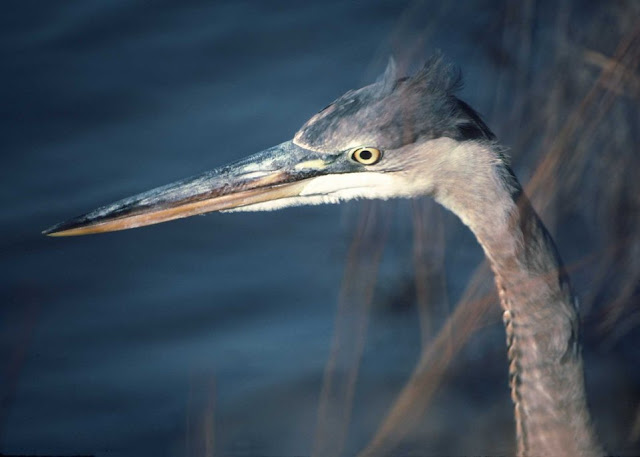 |
| Add caption |
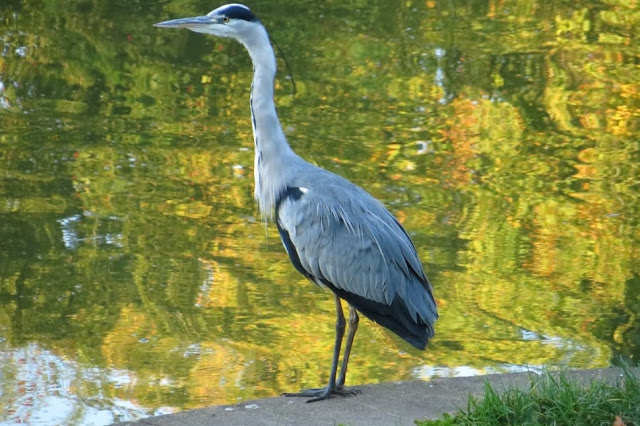 |
| Add caption |
Read More – The Lesser Goldfinch (Spinus psaltria) / The Himalayan Cutia / The fire-tailed myzornis / Pando – The One Tree Forest
Affiliates Links:
- How One Woman Discovered the Female Fat-Loss Code Missed by Modern Medicine And Lost 84lbs Using a Simple 2-Step Ritual That 100% Guarantees Shocking Daily Weight Loss
- 60 Seconds Habit ! That Reversed Type 2 Diabetes and Melted 56 lbs of Fat
- Boost Your Energy, Immune System, Sexual Function, Strength & Athletic Performance
- Diabetes Remedy # 1 Mega Offer for 2019
